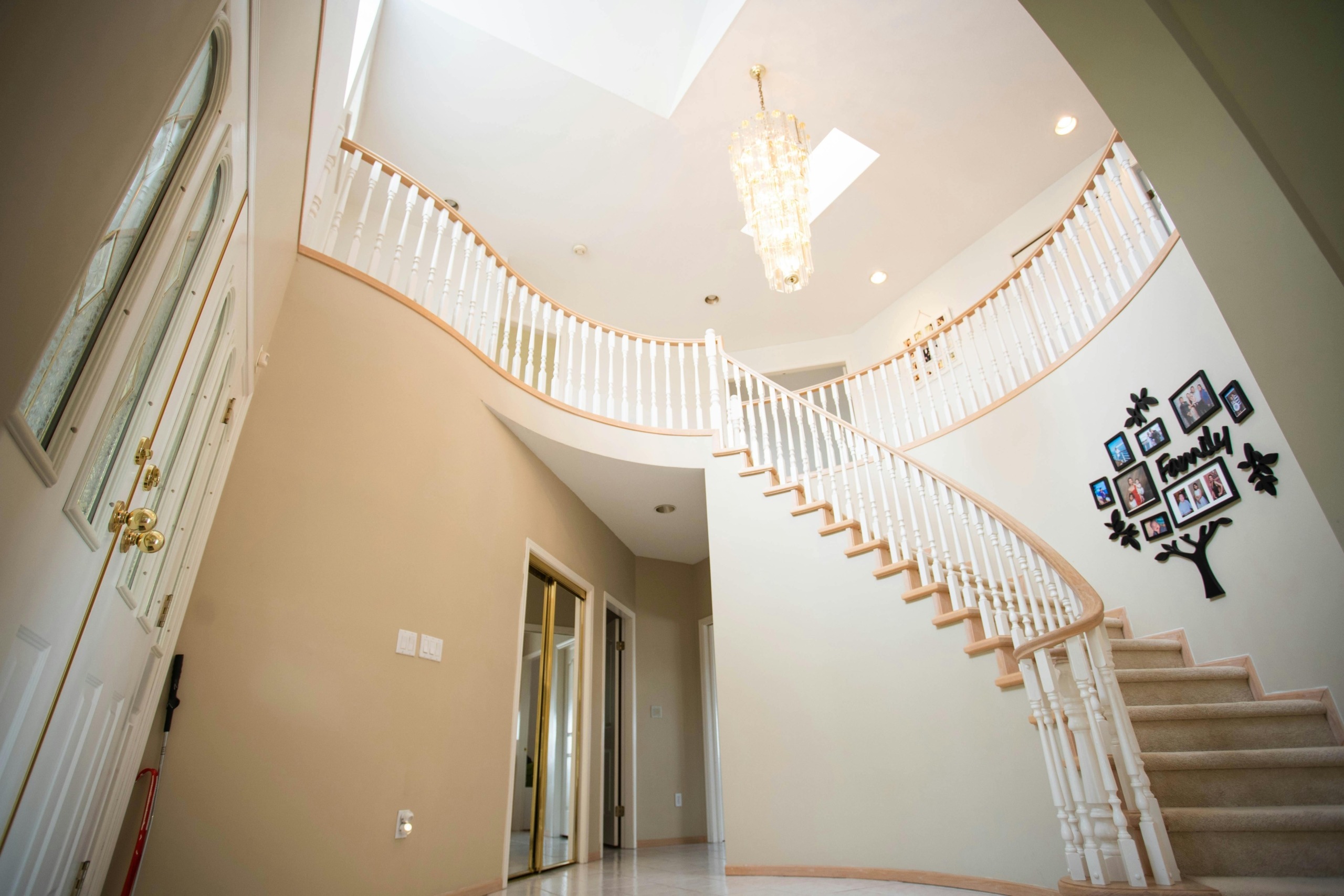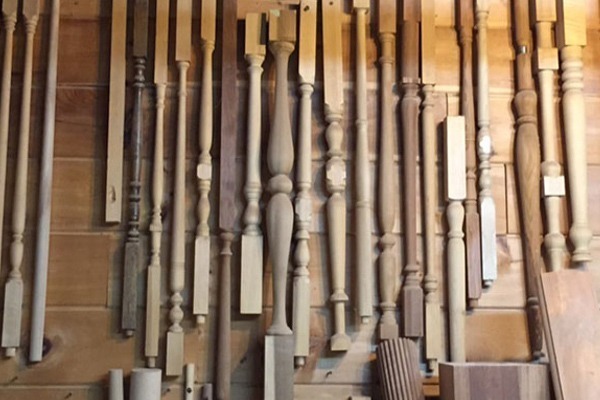Staircases are becoming a main focus of interior design. And among the leading staircase trends in 2025, the wood-on-wood staircase is dominating.
This style of staircase strips away the flash of mixed materials and returns to what feels honest. If you’re building new or remodeling, this design direction deserves your attention.
What Is a Wood-on-Wood Staircase?
A wood-on-wood staircase uses wood as the primary material across every visible component, including balusters (spindles), handrails, treads and risers, and newel posts and caps.
By sticking to a single, unified material palette, these staircases give your home a clean look. It’s also one that can shift between modern minimalism and coziness, depending on the details you choose to add or leave out.

Curved Wood-on-Wood Staircase with White Spindles – 2025 Design Trend
A curved wood-on-wood staircase featuring turned balusters and natural tones—an elegant entryway that reflects 2025’s top staircase trend.
Why It’s Trending in 2025 (& Likely Will Continue)
Design Flexibility Across Home Styles
The wood-on-wood approach works across different aesthetics and tastes. Owners of modern homes often choose squared profiles with light-stained white oak or ash. Traditional homes will often have turned spindles, darker stains, and classic newels in species such as cherry or walnut. Farmhouse or rustic styles will use distressed finishes, oversized spindles, and reclaimed wood.
This flexibility is exactly why it’s leading the staircase trends of 2025. It fits your space without fighting your style!
Warmth That Ages Gracefully
Unlike cold metal or sterile glass, wood is both tactfully comfortable and visually grounding. As trends shift back toward earthy tones, homeowners are using wood to make their homes feel both elevated and lived-in.
Cost-Effective Customization
Styles such as ultra-modern floating glass stairs can blow up your budget, fast. A wood-on-wood staircase offers an impressive design impact without the same cost. Affordable species can keep things budget-friendly, while premium woods add long-term value.
Design Features to Watch
Your design choices extend beyond the wood you choose.
Balusters (Spindles)
Newel Posts
Handrails
Pairing the species and stains along with your chosen styles matters as well. Lighter stains keep things feeling new and fresh while darker stains feel classic. For more information on wood species, visit our species guide. If you’re looking for more information on finishing options, visit our finishing and printing options page.

Selection of Wooden Balusters for Staircases and Railings
A variety of wooden balusters, each crafted for different architectural and design applications in staircases and railings.
Styling Your New Staircase
To make your staircase design stand out, consider a few styling enhancements.
Lighting, such as LED strips beneath the treads or tucked under the handrail, adds an edge. The ambient glow can increase safety and simultaneously highlight the wood.
Wall color is also huge. White, greige, or taupe won’t overwhelm the room. Bold paint colors can work, but they can also distract from the staircase itself. If you want your stairs to be the feature, keep the surroundings minimal and on the quieter side.
Adding a stair runner is another way to add style and practicality. Patterned runners look great, reduce noise, and protect the wood from wear.
Finally, pay close attention to the details. Hand-carved spindles, visible joinery, or bold grain patterns are design statements that make a big difference. These personalized details are what separate a stock staircase from one that reflects the character of your home.
Why More Homeowners Are Choosing Wood-on-Wood
In addition to the design factor, the practicality of wood-on-wood staircases is also a big reason behind their growing popularity. Hardwoods will hold up to years, if not decades, of consistent foot traffic without showing significant wear. If damage does take place, wood can be sanded and refinished. Other materials such as glass or metal often need a full replacement.
Wood also has a quality of comfort that other materials lack. It isn’t cold like steel or as sterile as tile. Beyond that, wood provides many opportunities for customization. From the grain pattern to the stain color to the profile of each component, everything can be tailored to you.
Maintaining a Wood Staircase
One of the best aspects of wood-on-wood staircases is how easy they are to maintain. Choosing a satin or matte finish helps hide everyday scuffs and minor wear. Day-to-day upkeep is simple: a microfiber cloth and a wood-safe cleaner are usually all that’s needed to keep things fresh. Every few years, depending on usage, a light sanding followed by a recoat will help preserve the finish and extend the life of the staircase.
Is 2025 the Right Time to Upgrade?
If you’re already considering a renovation, or in the middle of building your dream home, this is the year to change how you think about your staircase.
With the shift in home aesthetics toward natural materials, wood-on-wood staircases are perfectly aligned with what’s happening right now. The customization available today also mean you no longer have to compromise and settle for stock options that feel bland and uninspired.
Perhaps most importantly, your staircase is a missed opportunity in many homes. It’s one of the first things guests see and one of the most visible architectural features in a two-story space. Instead of letting it fade into the background, turning it into an anchor can give back to you for years to come.
Arnold Wood Turning crafts high-quality staircase components, from balusters to newel posts and more, designed to match your home’s style and your personal taste.
Reach out today for a free quote. We’ll help you remodel your staircase with ease.
Still shopping around and not ready to reach out yet? No worries! Visit our architectural wood products gallery here to see examples of just a few projects we have completed for customers.
